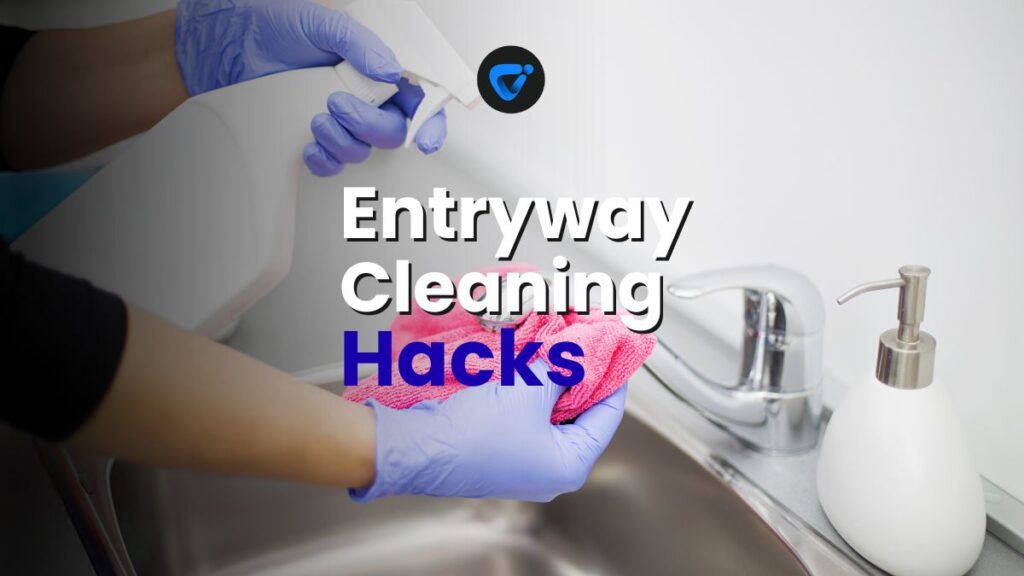
Dirty shoes, paw prints, and leaves seem to sneak into homes the instant the front door opens. Managing traffic at the threshold is a small but mighty form of entryway cleaning that delivers long-term rewards.

Pantry Organization and Deep-Clean Checklist
Transform your kitchen fast! Follow our pantry organization and deep-clean checklist for a fresh, clutter-free space.
When smudges and grit accumulate at the entrance, every step inside drags particles deeper into carpets and hard floors. Entryway cleaning routines can completely change how clean your home feels day-to-day, and they’re surprisingly doable.
Whether you’re dealing with city dust or rural mud, simple tweaks ensure dirt stays outside where it belongs. Dive into these practical entryway cleaning strategies and see how a few new habits can transform your whole home.
Establishing Your Entryway as a Dirt-Blocking Zone
An effective entryway cleaning setup starts by targeting where outside debris first arrives—right at the door. Immediately addressing this spot blocks much of the dust and grit that would otherwise scatter inside.
Start by designating a clear “removal and drop zone” for shoes and outerwear. Instruct family and guests with a sign or friendly reminder to leave footwear and wet items at the entry. Simple routines pay off fast.
Creating Dual-Mat Systems for Maximum Effectiveness
While one sturdy mat helps, a pair offers better defense during entryway cleaning. Place a coarse, weather-resistant mat outside. Use a softer, absorbent mat inside to capture remaining moisture and fine dirt.
Check mats weekly for packed-in dirt and shake or hose them to keep their fibers active. Rotate their positions seasonally, as front and back door traffic patterns often shift between summer and winter.
A dual-mat system mirrors how mudrooms function—do the bulk of scraping outdoors, then dry and trap indoors. This simple setup can cut visible entryway soil by half in moderate climates.
Setting Up a Shoe Removal Command Center
Place a stylish, washable shoe tray or rack just inside the door. Position seating nearby to make the habit easier, especially for guests or kids balancing on one foot.
Install open shelving or a small cabinet to corral frequently used shoes. Keep it near the door and clearly separate “outdoor only” pairs from clean indoor footwear, limiting cross-contamination.
Add a sign or decorative reminder that says, “Shoes Off, Please—Help Us Keep Floors Clean.” Friendly signage cues visitors to participate. Consistency here is key for sustaining this first line of entryway cleaning every day.
| Zone | Main Function | Cleaning Frequency | Takeaway |
|---|---|---|---|
| Outdoor Mat | Scrape grit, mud, larger debris | Weekly shake, monthly wash | Invest in a rugged style and clean regularly |
| Indoor Mat | Catch moisture, trap fine soil | Vacuum weekly, wash monthly | Choose a washable, absorbent material |
| Shoe Tray/Rack | Contain drips, keep shoes organized | Wipe weekly, deep clean seasonally | Use trays with raised edges to capture runoff |
| Seating Area | Ease of shoe removal | Dust and vacuum monthly | Add a bench or sturdy chair for comfort |
| Wall Hooks/Shelving | Store hats, jackets, bags | Wipe monthly, declutter seasonally | Use for daily essentials only |
Layering Entryway Surfaces and Storage for Cleaner Results
Entryway cleaning succeeds when every surface—with or without shoes—stays simple to wipe down or sweep. Layer surfaces strategically, so cleaning takes seconds rather than minutes.
Built-in storage bins, baskets, and trays collect stray items, helping maintain visual order and limiting spots where dirt can settle unnoticed.
Smart Surface Choices that Save Effort
Opt for hard, sealed flooring—tile, vinyl, or coated wood—instead of textured rugs or carpet. Use washable runners if softness is necessary.
- Place a non-slip, machine-washable runner between the main door and living spaces to catch lingering dust.
- Select wipeable trays for pet leashes and sports gear to defend against mud on rainy days.
- Use baskets with solid liners near seating to collect gloves or hats for a streamlined look and simple weekly shake-outs.
- Mount floating shelves above shoe zones, so dropped grit can’t accumulate out of sight.
- Limit decor clutter; fewer items means faster dusting and less grime hiding behind bases or under hooks.
Use these recommendations for every entry, even side or garage doors, to maintain year-round entryway cleaning with less hassle.
Daily Maintenance Habits Worth Building
Dedicate one minute per day to entryway cleaning with a quick scan and tidy routine. Wipe visible drips, corral out-of-place shoes, and shake mats.
- Hang a microfiber cloth by the door for fast spot clean-ups after rain or snowy days, so slip hazards never have time to build.
- Keep a handheld vacuum charged nearby to quickly capture tracked grit before it spreads into carpets.
- Set a weekly reminder to empty bins and wash baskets, so odors or hidden buildup never surprise you.
- Let natural light help—open curtains or blinds to spot footprints and dust earlier, especially in high-traffic morning hours.
- Encourage household members to “reset the entry” before dinner or bed, making it a shared habit instead of a chore for one person.
These micro-habits layer for reliable entryway cleaning success, helping you outsmart seasonal messes every week.
Staying Ahead of Seasonal Entryway Cleaning Challenges
Seasonal changes create unique entryway cleaning challenges—think melting snow, leaf piles, or pollen—and require different tools and tactics all year long. Adjust your routines proactively as soon as temperatures or weather shift.
Like swapping out your wardrobe, preparing your entryway at the season’s start helps you handle what’s ahead rather than playing catch-up after messes appear.
Spring and Summer Entry Tactics: Dust, Pollen, and Rain
Pollen coats shoes and door sills in spring, while summer brings sandy footprints from outdoor adventures. Start every week by damp-wiping doors and frames—pollen clings to static and can spread easily indoors.
Install a boot scraper by outdoor steps if your household regularly tracks sand, gravel, or garden soil. Reinforce a strict no-shoes-indoors routine, especially during the highest pollen weeks.
Choose mats rated for moisture—rubber-backed and quick-dry—so spring thunderstorms never result in wet, slick tile. Fast-drying mats mean shoes dry quickly and floors stay safer, with less grit tracked far beyond the door.
Fall and Winter Defenses: Wet Leaves, Slush, and Salt
Layer two hard-bristle doormats during leaf and slush seasons to scrub boots before they cross the threshold. Give kids and guests a brush or towel at the door for wiping sneakers or paws.
Use a raised-edge boot tray with gravel or river rocks in the base to help water drain from footwear and prevent puddling. Remove salt and de-icer residue with a daily spritz of water and vinegar—salt can strip flooring finish if ignored.
Rotate mat and runner placements to dry between uses and avoid mold. Deep clean trays and mats after snowstorms to prevent lingering odors. Stay ahead of slipperiness by keeping a stash of absorbent towels on a nearby hook for unexpected messes.
Consistent Entryway Cleaning Changes the Whole Home
Simple, regular entryway cleaning routines stop grit and allergens at your doorstep—saving you effort elsewhere. A layered approach, using strategic surfaces and storage, keeps your high-traffic zone guest-ready and healthier all year.
Prioritizing a tidy entry shifts the vibe of your whole home. Each small tweak—shoe trays, dual mats, quick daily resets—builds to reliably cleaner floors and less deep-cleaning down the road.
The next time you brush off your welcome mat or spot a muddy footprint, know these habits are your real defense. Keep dirt outdoors, and your home becomes a cleaner, more relaxing place, one step at a time.
Frequently Asked Questions
Place a polite sign at eye level and provide a bench or chair next to a visible shoe rack. Friendly reminders and comfort cues increase participation.
Shake mats outside weekly and wash them at least once a month. During rainy or snowy seasons, wash more frequently to keep them effective at trapping debris.
Yes, but check labels for compatibility with your specific flooring type. Mild soap and water work for sealed surfaces, while specialty cleaners protect hardwoods from salt and moisture damage.
Keep a microfiber cloth and handheld vacuum at the door. Spend 60 seconds wiping wet spots and vacuuming visible dirt right after everyone leaves for the day.
Choose vertical options: mounted shelves, wall hooks, and slim shoe racks. Use narrow mats, and add over-the-door organizers to maximize space without crowding walkways.

Pet Areas: Odor Control and Hair Management
Keep your home fresh and fur-free! Discover easy odor control and hair management tips for cleaner pet areas.


